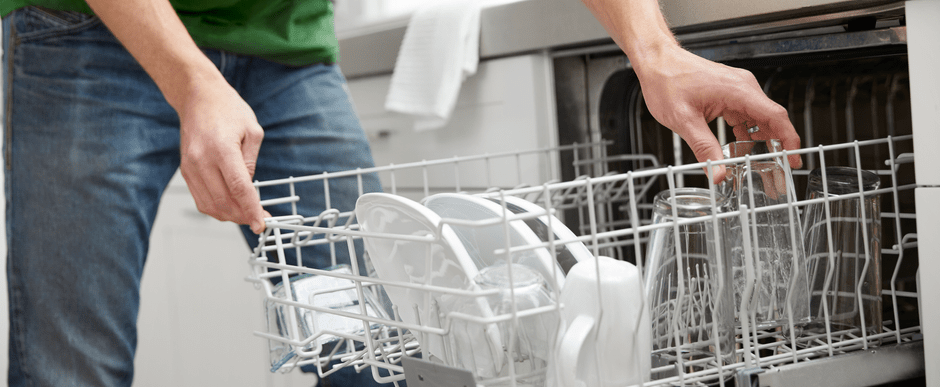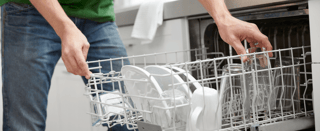Six reasons your dishwasher is leaking
Common causes for leaks and easy fixes for dishwasher-leak DIYers

Key tips to remember
- Get out of the habit of overfilling your dishwasher, which can cause leaks
- Always cut the power to your dishwasher before doing serious troubleshooting
- Drainage and doors are often the cause of a dishwasher leak
- Don’t forget to double-check your dishwasher’s alignment
- A home warranty can save you a lot of time and DIY struggles
Do you know how to clean and maintain a dishwasher? Regardless of your answer to that question, is your dishwasher leaking water underneath the unit? If your dishwasher sometimes leaks, particularly if this is something you haven’t experienced before, it can make you exasperated, wringing your hands and screaming, “Why is my dishwasher leaking from the bottom?” If a scream helps you vent, by all means, let one loose. Feeling better now? Hopefully, you didn’t terrify anyone around the house with that blood-curdling shriek. The good news is that a leaking dishwasher doesn’t have to mean a huge repair bill, and if you’re even the least bit handy or slightly into trying a DIY fix, you’re in luck.
If a dishwasher leaking from a bottom-type problem is what you’re dealing with, we’re here to help. In this post, we’ll go over the most common cause of dishwasher leaking, and then some. We’ll also give you some helpful ideas on how to fix it yourself without calling for professional service. Start by finding the manual, whether in-hand or online, and see what it says in the dishwasher troubleshooting section. If you follow the reset instructions and still notice a leak when the dishwasher is running or afterward, read on.
Safety first
First things first, go to your breaker box and turn off the power to the circuit powering your dishwasher, then unplug the dishwasher. Next, turn off the water valve under the sink. Now you can go ahead and tend to the mess. The last thing you want is for someone to get hurt due to a slippery floor or an electrical hazard, so mop up any standing water around the unit. This will also help you avoid damage to the floor and your cabinets due to water exposure. While you’re working on the dishwasher, you’ll want the power to remain disconnected.
Drainage leaks
One quick check you can go ahead with is to see whether the leak happens when the kitchen faucet is running. If it is, you have a drainage problem. You should be able to correct it by making sure the drainpipe is higher than the sink drain. If the leak happens when the dishwasher runs, you might have other problems, like a clog in the drainpipe, which you can usually access from the kickplate at the bottom of the front of the unit. Check the length of the pipe for any holes or kinks, verifying no clamps are missing or out of place. Tighten any loose fittings, and go ahead and replace the entire plastic hose if you need to. Otherwise, read more in our post on what to do when you have a clogged dishwasher drain.
Detergent leaks
You may not have considered this, but the type of dishwasher detergent you use can cause leaks, especially if it’s plain old dish soap, which is a major no-no. This type of soap is not designed for dishwashers and can cause too much foam, which could eventually (or even immediately) break the door seal and cause overflow leaks. Regular dish soap should never be used in a dishwasher. Resolve to make no exceptions to this rule.
Door leaks
If water accumulates on the floor right in front of the dishwasher, and your drain and drain hose seem to be clear and functional, you might have a door leak. The first possible cause of a door leak to check for is the latch because if the door isn’t latching properly, leaks are inevitable. You can tighten the latch with a screwdriver or even replace it if necessary. While you’re in there, you might as well check the hinges and tighten any if loose. The next possible cause of a door leak is the gasket, which can crack and dry out over the years with continual use. You can peel away an old gasket with your fingers. Clean out the ditch with warm, soapy water and a sponge, and let dry before replacing it with a new gasket. You can warm it up first with a hair dryer to make it a little pliable and easier to insert.
Tub and pump seal leaks
Sometimes even the tub in the bottom of the dishwasher experiences enough wear and tear and cleaning-chemical exposure that a hole can develop and result in a leak. Depending on the size of the hole and your ability to find the appropriate waterproof epoxy solution to seal it — which might allow you to continue using the dishwasher — you may need to replace the unit. If you don’t find a tub leak, also check the pump seal underneath the machine to make sure the seal around the water pump is still intact. If it’s dripping or more obviously leaking, you’ll need to remove the pump housing to replace the rubber seal.
Inlet valve leaks
Clamps, clips and various connections inside your dishwasher have a way of working themselves loose over time, which is why it’s a good idea to get in there and have a look around occasionally. You want to be sure that your inlet valve is working well and hasn’t become stuck. The inlet valve lets water into the tub during the cycle and can be found near the bottom of the unit. If it’s failing to open and close, overfill and leakage are likely. One way to tell if the inlet valve works properly is to open the door during a cycle as the unit fills with water. If the water keeps filling with the door open, the inlet valve needs to be replaced. Once you locate and acquire a replacement valve that fits your machine, take off the kick plate and remove the screws, clamps and hoses connected to the old valve. Remove the wires from the attached electrical solenoids. Be sure to label each one so you can accurately connect it to the appropriate spot on the replacement valve. Once you’ve removed the old valve, replaced it with the new one and reattached everything, you can replace the access panel.
Hose leaks
Hose or valve leaks require removing the kick panel from the front of the unit. This is where you can have a look at the drain hose again, as well as the water inlet valve and recirculation hose. If you spot any corrosion, bad solenoid valves or loose connections, you might have to patch some holes or replace some valves, hoses or other components. Replacing them is usually pretty easy, just have your dishwasher brand name and model number handy. You can even use your cellphone to take photos of the components you need to replace before hitting the hardware store, or just bring the parts in and ask for help.
Float switch leaks
First, get out of the habit of filling the dishwasher to the brim. It’s tempting, but it can cause plenty of problems, including leaks. A float switch is designed to keep the dishwasher from overflowing, but if the switch assembly catches on something, like that extra bowl you just had to cram in there, it could fail to do its job and result in a leak. One way to test this is opening the door midcycle, similar to the inlet valve check. This time, take note of the water level. If it’s higher than the element, that’s a telltale sign. Next, go ahead and remove the kick plate to get at the switch. From there you should be able to remove the wires and break out your multimeter for a continuity test. If the water level is higher than the heating element we mentioned and there’s a lack of continuity on your multimeter when you test the float switch, you need a new switch. To replace it, follow the manual and its instructions carefully, making sure to label parts and wires along the way as you disconnect them. After installing the new float switch, retrace your steps to reconnect everything accurately.
Alignment leaks
There’s one more thing we should mention about troubleshooting dishwasher leaks, and that is alignment. Making sure the unit is level and stabilized is an essential component of leak prevention. You can check with a level on the inside of the dishwasher and insert shims underneath if you find that it’s misaligned.
Wrapping up
At this point in your quest to fix dishwasher leaks, you might feel like your dedication to DIY home repairs has been tested to its limits or beyond. If you wonder whether a home warranty covers dishwashers, we wouldn’t blame you for reconsidering taking on the repairs yourself. Sometimes it just makes sense to have professional help. Thanks for stopping by, and please feel free to peruse our many other posts on all sorts of home maintenance, upgrades and fixes!
The information in this article is intended to provide guidance on the proper maintenance and care of systems and appliances in the home. Not all of the topics mentioned are covered by our home warranty or maintenance plans. Please review your home warranty contract carefully to understand your coverage.
